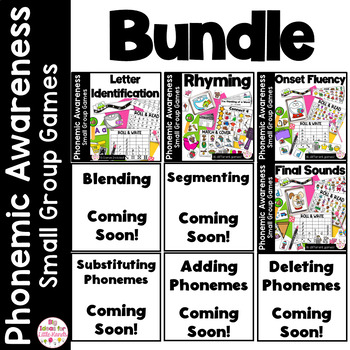Phonemic awareness is a BIG topic in primary education. There’s a lot to cover, and many different ways to go about it! If you’re feeling a bit overwhelmed by all the options, I’ve got good news! Today we’re chatting about the 8 key skills you should be looking for in a strong phonemic awareness program and my BEST tips to facilitate them!

What is Phonemic Awareness?
First things first! Phonemic awareness refers to the ability to identify, isolate, and manipulate sounds in spoken words. In phonics, sounds are called phonemes. Phonemes can be represented by a single letter or a combination of letters that make one sound.

Phonemic awareness is an essential piece of the puzzle when it comes to developing reading fluency. Children must master phonemic awareness skills to develop into strong and confident readers. Phonemic awareness skills are often introduced in preschool and taught in depth in kindergarten and first grade.
There are 8 key skills that you should be focusing on for strong phonemic awareness. Since these concepts are brand new to your little learners, it’s very likely that your students will need LOTS of repetitive practice with each of them before they achieve mastery. Luckily, I’ve got a perfect solution for you to keep this fun and interesting!
Using Games to Master Phonics Skills
Games are my secret weapon when it comes to maintaining engaged classroom learning all year long. I use them for just about everything we work on throughout the year, but I especially love them for phonemic awareness! Young students LOVE to play games, which means anytime I add them to my lesson plan, I can count on full engagement from my kiddos.
Plus, games help to keep our daily activities feeling fresh and new, even when we’ve been targeting the same skill for a while. Let’s dive into 8 skills you should be incorporating into your phonics lessons and some of my favorite games to support them!
1. Letter Recognition
First up, letter recognition is a very important step in developing phonemic awareness. By definition, we want students to be able to visually see a letter and recall its name and sound instantly. This is a skill that is practiced in preschool and kindergarten throughout the school year.
Personally, I love targeting letter recognition with whole group games, since it gives everyone an opportunity to see and hear the letter names as their classmates say them. When a student answers incorrectly, it’s also a great learning opportunity for the whole group. “Feed Me” is one of my favorites for group learning!
I provide my students with a set of cards that look like cookies and a sheet pan “face” with a mouth to “eat” the cookies. The objective here is to have students grab a letter card and say the letter names and/or sounds aloud. Next, they see if the uppercase and lowercase letters match to create a pair. If the card shows a matching pair, the cookie sheet is “fed” that cookie.
This is such a great activity for your morning meeting or circle time. I place the cookie sheet in the middle of the circle and have kids take turns choosing a card until all the cookies are “eaten”. Your students will love feeding the sheet pan cookies and it’s a great way to master both uppercase and lowercase letters!
2. Beginning Sounds
Mastering beginning sounds, also known as onset fluency, is so important to overall phonemic awareness. This skill refers to the ability to isolate specific letter sounds at the beginning of a word.
As a kindergarten teacher, this is something we target every single day, so it needs to be FUN!
One of my favorite ways to do just that is with a fun game, like BINGO. This classic game is perfect for targeting beginning sounds in small groups.
To play, I give each student a BINGO card filled with colorful pictures. I use cards to call out beginning sounds. Students will search their board and cover any pictures with that sound.
This game is always a favorite and it’s great anytime you’d like a quick and engaging way to brush up on those beginning sounds with your kiddos!
3. Ending Sounds
Ending sounds or final sounds are another key component of teaching phonemic awareness.
This is exactly what it sounds like – mastering ending sounds is the ability to isolate the last sound in a word. Again, this is something we practice all the time in kindergarten.
I love using this pocket chart game to practice this skill with my students. To play, you’ll set up phonics picture cards in a pocket chart. Then, you’ll hide a bee card behind one of the phonics cards. Next, call on students to guess which card they think the bee is hiding behind.
As students guess, they will say the name of the phonics card and identify the ending sound for that word. Students will keep guessing until the bee is found. Then, hide the bee again and repeat the process. This game is perfect for a morning warm-up during circle time or anytime you find yourself with just a few minutes to spare before your next activity.
4. Rhyming
Rhyming might be my favorite skill to teach out of them all! There’s just something that screams fun about practicing rhymes with students, so engagement is always high. We use rhyming games as a whole group, in centers, and in small groups.
One of my favorite rhyming games is “I’m Thinking of a Word…” This guessing game is a great attention grabber and a great way to refocus your class after recess or during transition time. I keep a ring of guessing game cards for this activity in my circle time cart, so I can grab them anytime we have a few minutes to spare.
To play, I will choose a card, read the hints on it to my students and they take turns guessing the word. The hints say things like, “I’m thinking of a word that starts with /b/ and rhymes with pat”. My students LOVE this game for practicing rhyming!
5. Blending
Blending is defined as the method we use to combine different individual sounds or phonemes to form words. Essentially, blending sounds together teaches students how to sound words out. This skill comes in handy when children come across unfamiliar words in reading!
If you’re working on blending sounds with your kiddos, try one of my favorite games, Blender it Up! The idea behind this game is that students will practice breaking a word down into phonemes and then blending the sounds together.
Each child gets a blender cut-out with dots on it to represent the number of phonemes in the words we’re targeting. The teacher will use cards containing the target word list. To play, the teacher will say sounds aloud for a specific word. Students will tap the dots on their blender for each sound and then blend the sounds aloud.
This is a great activity to model in front of your whole class or in small groups to introduce the concept of blending sounds. Start off with words containing 2 phonemes, and work up to using words with 3 or 4.
6. Segmenting
Segmenting refers to the ability to identify individual sounds (phonemes) in a word. This includes beginning, middle, and ending sounds. This skill is typically practiced orally and without the written word.
I love practicing this one as a whole group using a fun video like this one. It uses visuals to help kiddos identify the number of sounds in a word, then break apart those sounds and identify the phonemes. This is a great way to introduce this concept to your kiddos and practice as a group!
7. Phoneme Addition
Phoneme addition is a skill that involves adding phonemes to a given word to produce a new word.

For example, if you start with the word for and add the /t/ sound to the end, the word fort is produced.
Over the years, I’ve found this is a really fun skill for students. They enjoy practicing this phonemic awareness skill and “creating” new words!
A simple way to practice this with your small groups is with flashcards and letter tiles.
Use the flashcards as your starting word, and then pull a letter tile to add a phoneme.
Tap for each phoneme or use manipulatives to illustrate them easily.
8. Phoneme Deletion
Phoneme deletion is another skill that helps develop students’ phonemic awareness. Phoneme deletion involves having students manipulate words by deleting specific sounds. For example, you could ask your students to delete the initial /h/ from ‘hat’. This would produce the word at.

This is a fun skill to practice in small groups with simple materials. All you need is a dry-erase board, marker, and some picture cards. You’ll want to make sure you choose picture cards that can easily be manipulated into new words by deleting a phoneme to practice this skill effectively.
To get started, have students take turns drawing a card and naming the picture on it. Then, you can write the word on the board and have the whole group say the word aloud. Finally, ask the student who drew the card to delete a phoneme and produce a new word. Erase it to illustrate the new word after they answer.
You can also target this skill using manipulatives that represent each sound, taking one away to illustrate phoneme deletion. Either way is a great visual for students!
Get Started with Phonemic Awareness Games
Ready to dive into teaching these skills in your classroom? Using games is one of my favorite ways to ensure you’re touching on key phonemic awareness skills and aiming for a well-rounded phonics program. We use games every single day in my room and I’m a big believer in switching things up to keep it interesting.
If you’d like to get started with phonics games with your kiddos, enter your email below to be sent a FREE Rhyming Game you can try in your classroom!
And if you LOVED everything you saw here today, be sure to check out my phonemic awareness GROWING BUNDLE! This bundle is jam-packed with phonics games and it’s still growing! Grab it at a low price today and get future additions completely FREE! Have fun practicing these skills with your students!
Save This Post
Pin this post on Pinterest to keep these phonemic awareness activities handy!











